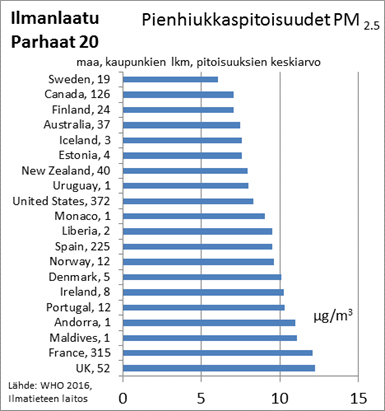WHO: Air in Finland third cleanest in the world
 Kuva: Eija Vallinheimo
Kuva: Eija VallinheimoThis was revealed by the extensive database published by the WHO, which includes measurement data on particulate matter from 3 000 localities in a total of one hundred countries between 2008 and 2014. In addition to Finland, the air in Sweden, Iceland and Estonia is clean, i.e. particle concentrations remain under 10 µg/m3 in comparisons with other European countries. Countries such as Canada, Australia and New Zealand are in the same top class in global comparisons.
The highest particle concentrations, in other words, the countries with the worst air quality are located in the Middle East and Far East as well as in Africa. The levels of particle concentrations in these countries are more than tenfold in comparison with the best levels in the report. Annual concentrations of more than one hundred micrograms (more than 100 µg/m3) are measured in Riyadh in Saudi Arabia, Delhi in India, Bamenda in Cameroon, Baoding in China and Peshawar in Pakistan.
The measurement station in Pallas measures the cleanest air in the world
The Finnish Meteorological Institute FMI's measurement station in Sammaltunturi in Pallas is one of the places that measures the cleanest air in the world. Places as clean as Sammaltunturi, or places in which particle concentrations remain under 4 µg/m3 also include locations such as Hafnarfjordur in Iceland and Te Anau in New Zealand.
"When it comes to the results, we must take into account that there is a lot of uncertainty about the measurement data from developing countries, as their measurement quality is not necessarily very reliable and the number of measurements is small, so the regional representation remains low," Senior Research Scientist Pia Anttila from the FMI points out.
Considerable air quality problems in developing countries
However, the report highlights the big air quality problems in developing countries. The reference level for particulate matter recommended by the WHO is 10 µg/m3. "This level was exceeded in more than two thousand cities. The number of people who are exposed to air pollution in the metropolises in Asia and Africa is indeed huge," says Pia Anttila.
Altogether 22 cities from Finland (Raahe, Kuopio, Lohja, Jyväskylä, Valkeakoski, Kajaani, Vaasa, Imatra, Pori, Mikkeli, Virolahti, Kouvola, Harjavalta, Turku, Kotka, Oulu, Lahti, Pietarsaari, Hyvinkää, Lappeenranta, Vantaa, Helsinki, Tampere) as well as FMI's measurement stations in Pallas/Muonio and Virolahti participated in the report. The measurement data from Finland is from 2014.

Levels of fine particulate matter PM 2.5
Further information:
Ambient Air Pollution Database, WHO, May 2016. http://www.who.int/mediacentre/news/releases/2016/air-pollution-rising/en/
Senior Research Scientist Pia Anttila, tel. +358 50 368 6420, pia.anttila@fmi.fi
Journalists can join FMI on a familiarisation trip to Pallas measurement station 6–7 September. For further information about the trip, please contact the FMI's communications department, tel. +358 50 530 3871, communications@fmi.fi.